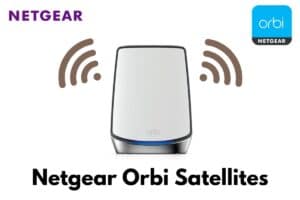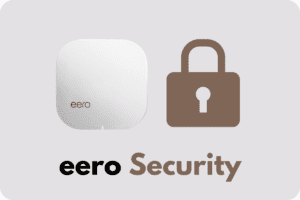8 Best Zigbee Devices for Zigbee Homes
We’re reader-supported; we may earn a commission from links in this article.
According to Onworld, more than 1 billion Zigbee chips will be sold by the end of [thisYear], constituting the largest share of smart devices.
And for good reason – the Zigbee protocol has low latency, ensures prolonged battery life, lower power consumption, and wide-range coverage.
With so many Zigbee devices in the market, you may find it hard to pick the right one for your Zigbee smart home.
In this article, I will cover the best Zigbee devices that’ll fit right into your Zigbee system!
Read on for more!
What are the best Zigbee devices?
After many hours of research, I have picked the best Zigbee devices in [thisYear] listed below:
Let’s discuss these devices in detail to know why they are best fit for home automation.
1. Aeotec Smart Home Hub
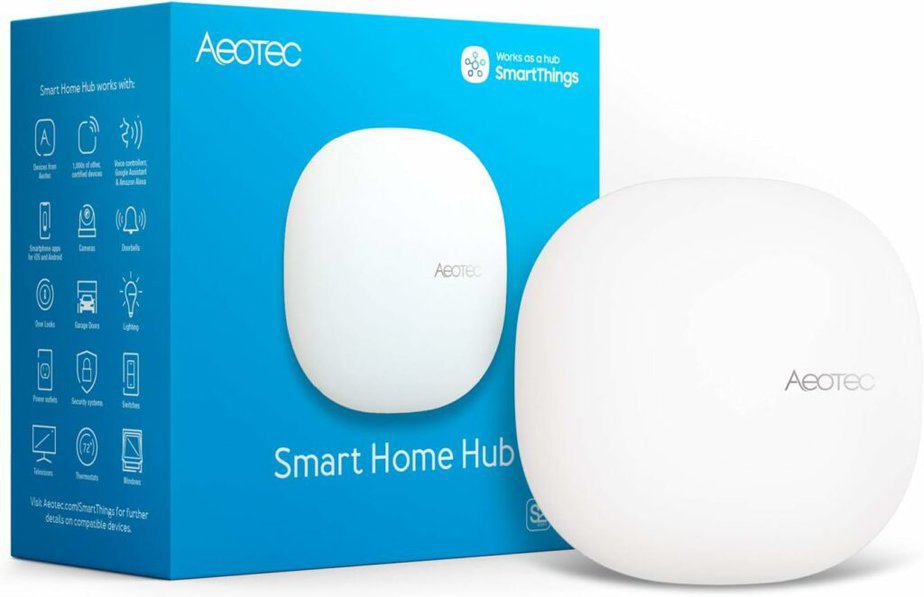
The Aeotec Smart Home hub is the best and one of the most essential devices in Zigbee home automation.
As it works with the Zigbee protocol, it can control all the other Zigbee devices in this article’s list.
Additionally, this device is certified to work with other home automation protocols such as Google Assistant, Amazon Alexa, and Apple Homekit.
The Synchronization over SmartThings app provides sophisticated control with a sleek user interface. The intelligent design of this hub lets you mount it on the wall for better coverage.
Key Features:
- Easy to set up using the internet via the SmartThings app
- Connects to Over 5000 devices from dozens of brands
- Works with Zigbee, Wi-Fi, Matter, and Z-Wave connectivity protocols
- Control with Ring, Google Assistant, SmartThings, Amazon Alexa, iOS, Android
- Automation still works even if the internet is down
- Works with Alexa and Google Voice Assist
- Compact Design that mounts on the wall
- Compatible with audio brands (Bose, Samsung, Sonos), Doorbell and Cameras from devices (Aeotec, Nest, and Ring), Thermostats, and all kinds of sensor
- Allows mesh networking to increase the range
Cons:
- Requires ethernet to set up
- Use Wifi spectrum 2.4 or less
Bottom Line:
Aeptect Smart home Zigbee hub works as the brain of communication between devices. It functions smoothly and connects with many devices to improve automation.
Due to its compatibility, I ranked it first among Zigbee-supported hubs.
2. THIRDREALITY Zigbee Contact Sensor
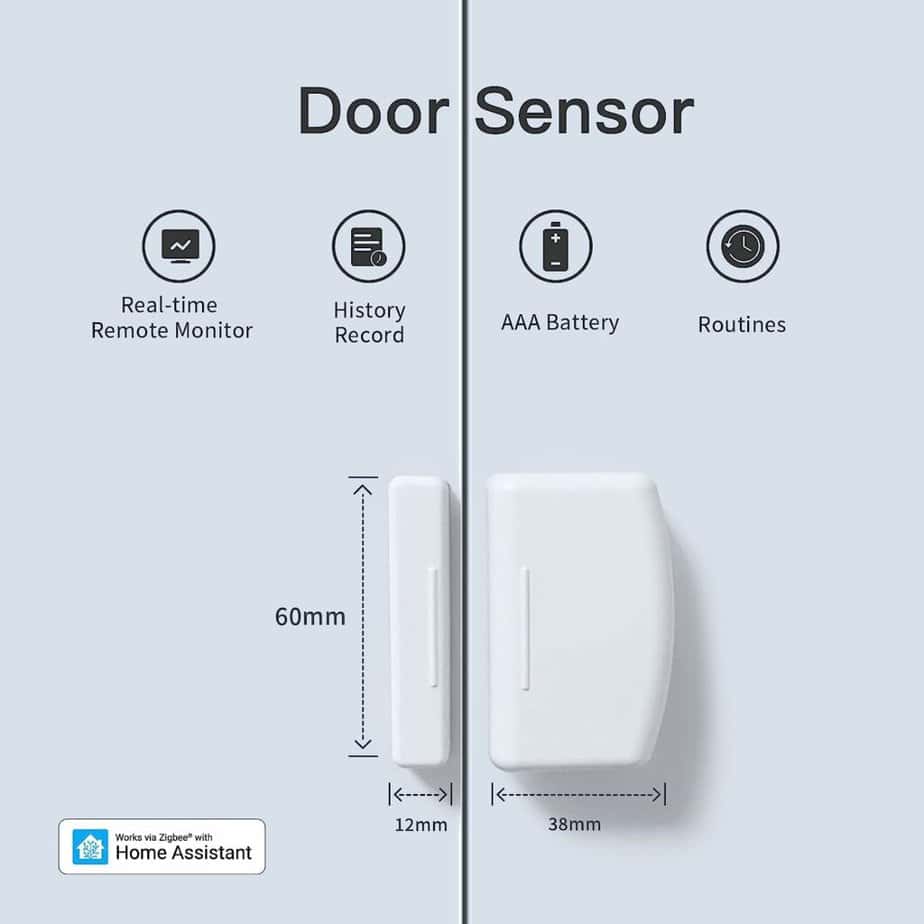
Doors and window sensors work using contact detection principles.
Following instructions fed into the Zigbee chipset produces signals that go to the central hub to generate alarms and other tasks.
After fact-checking, research, and user evaluation, I have found the THIRDREALITY Zigbee Contact Sensor to be the best of its kind due to the following features.
Key Features:
- Zigbee standard compatible door and window sensor
- Hassle-free setup -sets up in seconds
- Works on most of the doors and windows
- Battery lasts for two years and is easy to replace
- Adapts to usual routine with the help of Alexa
- Connects with the Thirdreality app to check details such as battery life and history
- Sends warnings on your phone when the doors and windows breach and open abnormally
- Remote monitoring features to protect your homes
Cons:
- It needs to be installed inside the house
- Customers have found it needing help to mount on doors and windows.
Bottom line:
Due to its long-lasting batteries, ease of set-up, and compatibility with other Zigbee devices, the Thirdreality contact sensor is the best.
3. Aqara Smart Plug
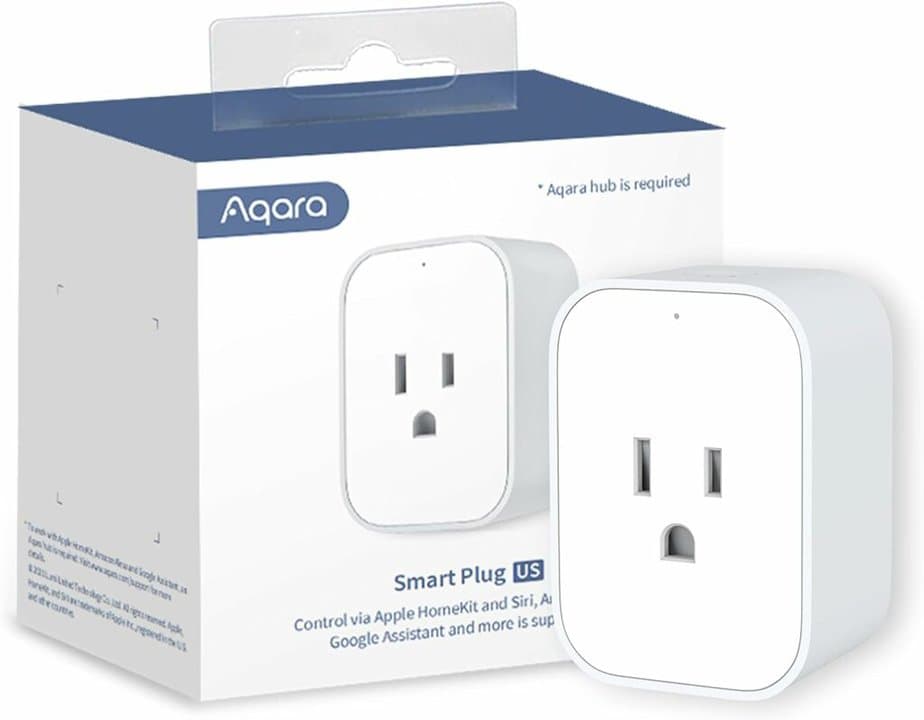
Third on the list is the smart plug because of its essential role in the smart home ecosystem. It connects with the power outlets in the walls and controls the flow of electricity as required.
If there is fluctuation in power or overheating, it disconnects the devices to avoid significant harm.
I have followed and researched many smart plugs from brands like Aeotec, Toya, VENZ, and Sengled and concluded that the Aqara smart plug is one of the best Zigbee devices due to the following features.
Key Features:
- Easy to mount and set up with an Aqara-intelligent system.
- Works with Alexa voice assistant by ECHO.
- Control your devices remotely from anywhere with smartphones.
- Supports the schedule, timer, and scenes set with the Aqara home app.
- Monitors energy consumption of different devices to save power.
- On-and-off operation mode with plug-in connection type on 15 Amp current rating.
- Provides overheat and overload protection.
- Comes with multiple safeguard features to ensure safety.
Cons:
- Works only with the Aqara Hub.
- The maximum current rating is 15 Ampere.
Bottom Line:
Despite functioning for Aqara-supported hubs only, the smart plug offers multiple features that make it superior to other smart plugs.
It provides state-of-the-art security, power control, and functions. If you already have an Aqara smart hub, I recommend you choose this smart plug.
4. Aeotec SmartThings Button

Made explicitly for SmartThings and Aeotec hub, the Zigbee remote button works for Zigbee devices.
It is compatible with most brands, excluding Nest, Sonos, D-Link, and Blink. Due to its range and smooth response to commands, this fits the list of best Zigbee devices for smart homes.
Read on key features to know more about this product.
Key Features:
- Easy to install and configure into your smart system
- Controls lights, fans, security, and other smart home devices
- Has an integrated temperature sensor
- Easily mountable on walls with magnets or 3M adhesive
- Covers an area of two-story building around 3000 sq ft
- Quickly able to switch between scenes
- Works on batteries, which means there is no need for a wired connection
Cons:
- Slightly tricky to connect with other brands
- Users have found it hard to place batteries inside the button
Bottom Line:
The button works effortlessly, especially with SmartThings and Aeotec hubs.
With smooth functionality and comprehensive range coverage, it has been proven to be one of the best remote smart buttons that support Zignee connectivity protocol.
5. THIRDREALITY Zigbee Motion Sensor

Motion sensors amplify smart home automation by detecting motion by controlling devices and the ecosystem.
The battery-powered Third Reality Zigbee motion sensor is one of the best Zigbee devices I have researched. It works as a Passive infrared (PIR) sensor to detect motions of all kinds.
You can also control this motion sensor according to your routine. For example, you can set a command, “ When I come back from work, turn on the lights and fan.”
It will detect the motion to turn on the fan and lights. Following is the list of its key features:
Key Features:
- Zigbee Standard Device that works with Zigbee hubs
- Compatible with Echo devices, Eero, Home Assistant, Aeotec, Hubitat, and third-reality smart speakers
- Routine Capable (creates routine and automates the function as you require)
- Collaborates with smart lights, smart plugs, and Alexa to sense motion
- Installs in seconds with an easy guide
- Detects motion 30 feet or 9 meters away
- Batteries last over two years
- Mounts on walls and shelves according to your interior design
- Communicate and control through your Android phone
- Innovative and Sleek design with elegant colors
Cons:
- No sensitivity adjustment options are available
- Triggers on pet motion, such as cat
Bottom Line:
The Thirdreality motion sensor beats the other Zigbee motion sensors because of its compatibility, easy installation, intelligent routine setting, sleek design, and broad coverage.
If you have a smart home working on Echo, eero, hubitait, Aqara, SmartThings, or Aeotec, the Thirdreality Zigee motion sensor is the best for you.
6. OUVOPO Zigbee Contact Sensor

The security of a smart home depends on reliable door and window contact sensors.
While keeping functionality, price, battery, and compatibility in mind, the OUVOPO Zigbee Contact Sensor is one of the best Zigbee devices available today. This contact sensor has valuable features to keep your home secure.
Key Features:
- Works with Zigee hub and Wi-Fi 2.4 GHZ
- Compatible with Echo devices, eero, Home Assistant, SmartThings, Aeotec and Hubitat
- Can set routine controls with Alexa
- Provides Excellent Expansion by adding more sensors for a complete security system
- Works on low-powered battery due to Zigbee technology
- Offers convenient and flexible installation in a few steps
- Sleek and compact design to mount on windows and doors
Cons:
- Customers have shown concerns over connectivity with other brands
- The design could have been more compact and better
Bottom Line:
For the security of your house, you need contact sensors that are expandable, function properly, and are compatible with other brands’ hubs. OUVOPO Zigbee contact sensor is just the device that follows the best Zigbee device criteria.
7. Aqara Temperature and Humidity Sensor
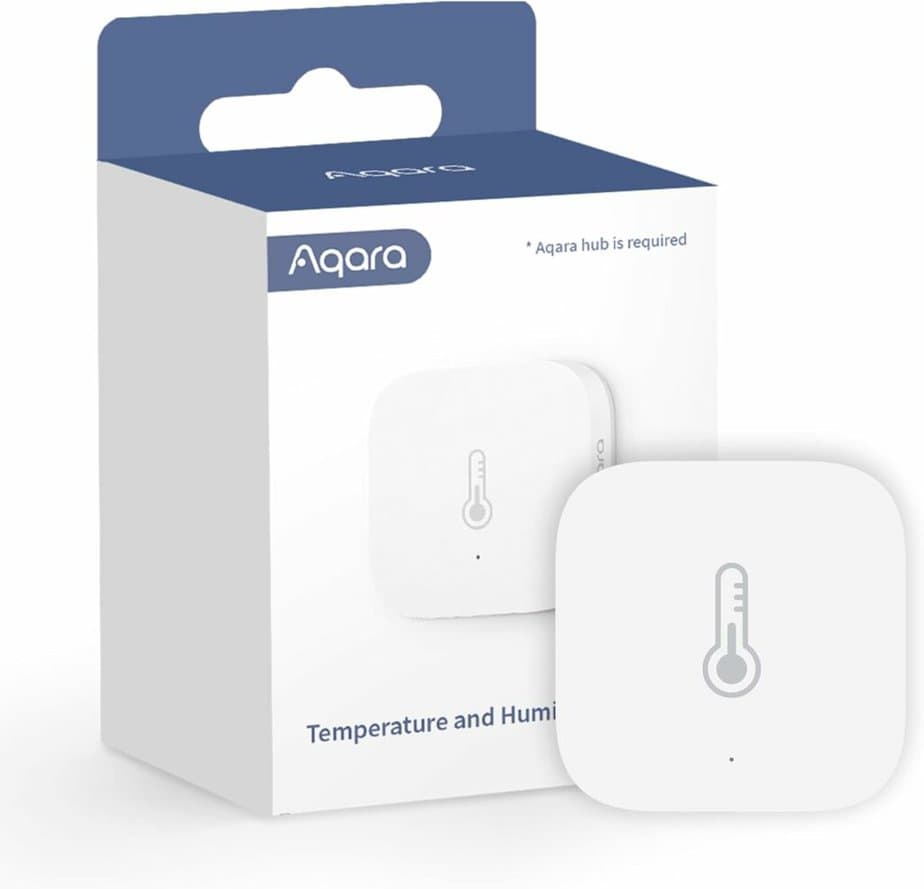
Temperature and humidity are two important factors that affect your personal and house health.
The Aqara Temperature and Humidity Sensor offers sensors that maintain temperature and humidity at ambient levels to detect the temperature and humidity. These sensors communicate with thermostats for a comfortable environment.
Key Features:
- Works best for Aqara smart home hubs
- Supports the Zigbee network and Wi-Fi protocol
- Offers remote control capability through your smartphone
- Utilizes high-quality sensors and calibrations to provide accurate measurements
- Has a built-in pressure sensor
- Supports Amazon Alexa and Apple HomeKit
- Records data and provides a history
- With the help of a smart plug, it automatically adjusts humidity and temperature
- Features Industrial-grade sensors with ±3% humidity detection accuracy and ±0.3% temperature accuracy
- Lithium battery powered and mounts on wall
Cons:
- Only works for Aqara smart hubs
- Customers have witnessed a short delay in recording data
Bottom Line:
If you are using an Aqara smart hub connected through Zigbee, this sensor is an ideal product for you.
It has industrial-grade accuracy, provides routine settings, and has excellent batteries. Thus, keeping your home warm and cozy is a game changer.
8. Enbrighten Zigbee Dimmer
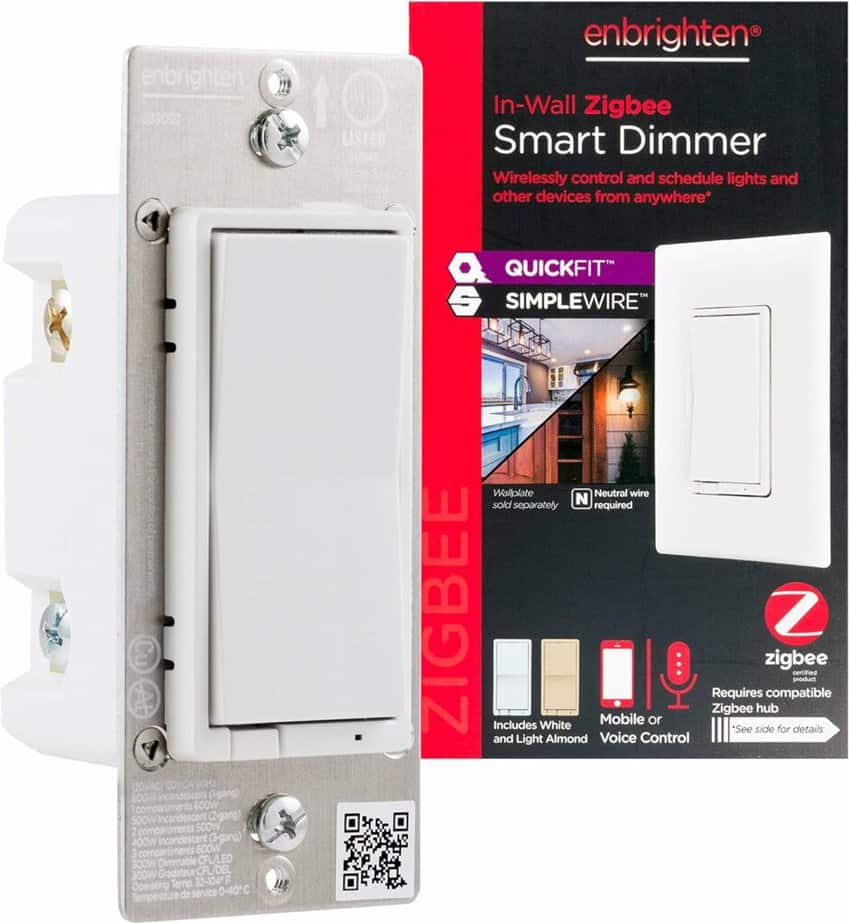
Smart Dimmers are a crucial part of smart homes as they help control the power input to devices such as lights, fans, and thermostats.
After research and customer feedback, I have found that the Enbrighten Zigbee dimmer is the best due to its compatibility, fair price, and function.
Key Features:
- Works on connectivity protocols Zigbee and Wifi 2.4
- Compatible with voice control such as Alexa and Google Assistant
- Innovative Design that installs on all kinds of walls easily
- Rapid Installation with simple wire
- Works on trusted, highly secure Zigbee 3.0 to keep your system private
- 20 % smaller hosing depth from previous models
- Line-Load terminal auto-detection
- Works on mesh networking and interchangeability of devices
Cons:
- Durability Issues have been noticed
- A buzzing sound keeps coming from the dimmer, which is slightly unpleasant
Bottom Line:
Due to easy installation, affordable price, sleek design, and easy installation, the Enbrighten Zigbee dimmer is among today’s best Zigbee devices. If you own a smart home with Zigbee communication protocol, I recommend it.
FAQ:
What is Zigbee technology, and how does it work?
Zigbee is a wireless technology that helps devices connect and communicate with each other and effectively works for low-powered devices in a machine-to-machine (M2M) style.
After Zigee protocol standardization, its use in home automation has skyrocketed, as seen in every other smart home.
The frequency band is the significant difference between Zigbee and other protocols, as specified in IEEE 802.15.4. While the other three technologies mentioned above operate under the 2.4 GHz spectrum, Zigbee can effectively function at lower spectrums, such as 915 MHZ and 868 MHZ.
What Zigbee Devices are needed for home automation?
There are countless Zigbee devices required for home automation. Here is a list of the most used and necessary instruments.
- Smart home hub (Central part to connect with devices and control automation)
- Zigbee supported lights
- Zigbee repeaters (to extend range)
- Motion sensors (to predict motion and follow commands)
- ZigBee dimmers (to control the power going to various devices)
- Zigbee temperature and humidity sensors
- Zigbee remote controls
- Zigbee smart plugs
- Smart cameras controlled by Zigbee
- Smart Zigbee-powered doorbell
- Smart lights for automation (Zigbee-supported)
- Zigbee fans, air conditioners and thermostats
- Smart locks with Zigbee functionality
These are the crucial Zigbee devices to automate a house.
What are the three types of Zigbee Devices?
Within a smart home, Zigbee has three kinds of devices, i.e., Zigbee Coordinators (ZC), Zigbee Routers (ZR), and Zigbee End Devices (ZED)
What is the typical Range of Zigbee?
Zigbee connectivity protocol can communicate between devices within 300 meters without hurdles. When used indoors, Zigbee 3.0 ranges from 75 to 100 meters.
What are the advantages of Zigbee?
Zigbee technology has the following advantages:
- Works on point-to-point network topology
- Long battery life due to low-duty cycle
- Low Latency
- Low-powered devices to save energy
- Affordable devices
How do I connect Zigbee devices?
To connect Zigbee devices, you’ll need a Zigbee coordinator or hub. Here’s a step-by-step guide:
- Purchase a Zigbee coordinator or hub: This device acts as the central point of control for your Zigbee network. Popular options include Philips Hue Bridge, Samsung SmartThings Hub, and Amazon Echo Plus.
- Install the coordinator or hub: Follow the manufacturer’s instructions to set up the coordinator or hub. Typically, you’ll need to connect it to your home Wi-Fi network and create an account on the corresponding app.
- Put your Zigbee devices into pairing mode: Refer to the user manual of each Zigbee device to find out how to activate pairing mode. In most cases, you’ll need to press and hold a button or follow a specific sequence of actions.
- Add compatible Zigbee devices to the coordinator or hub: Open the app associated with your coordinator or hub and navigate to the device pairing section. Follow the app’s instructions to add each Zigbee device to your network. This usually involves selecting the device type and following the on-screen prompts.
- Test the connection: Once the device is added, you can test its functionality through the app. Depending on the device, you may be able to control its settings, monitor its status, or automate it with other devices in your network.
That’s it! You’ve successfully connected your Zigbee devices.
Remember to consult the user manuals for any specific device requirements or troubleshooting steps. Enjoy the benefits of your smart home automation system!
Other Zigbee Devices to Consider
- INNR Zigbee Smart Plug
Final Thoughts
The listed products are the best Zigbee devices, vetted by user feedback and thorough research.
Home automation requires smart hubs, lights, fans, thermostats, repeaters, and sensors. The above-listed Zigbee devices are affordable, functional, and compatible with voice assistants.
To avoid loss or mismanagement, read about the features and cons of each smart device before purchasing them.
All the best in setting up your Zigbee-based smart home!

Justin Chia
Justin is the author of Justjooz and is a data analyst and AI expert. He is also a Nanyang Technological University (NTU) alumni, majoring in Biological Sciences.
He regularly posts AI and analytics content on LinkedIn, and writes a weekly newsletter, The Juicer, on AI, analytics, tech, and personal development.
To unwind, Justin enjoys gaming and reading.

